The 2011 Mid-Range SSD Roundup: 120GB Agility 3, Intel 510 and More Compared
by Anand Lal Shimpi on June 7, 2011 12:52 PM ESTA year ago whenever I'd request an SSD for review I'd usually get a 128GB drive built using 3x nm 4GB 2-bit MLC NAND die. These days the standard review capacity is twice that as most drives ship with 25nm NAND, using 8GB die. Seeing a bunch of scores for 240GB+ drives however is frustrating to all involved. At these capacities you're almost always looking at two die per NAND device, which has significant performance benefits due to interleaving. Most SSD controllers have eight NAND channels and with sixteen NAND deviecs with two die per device that's four NAND die that the controller can interleave access between for each channel. The 128GB drives by comparison halve the number of NAND, which only allows the controller to interleave requests among two die.


How read interleaving works on a single channel
Not only are these 240GB+ drives the best case performance you'd see from a particular SSD, they are also very expensive. At around $2/GB you're looking at over $500 for a high end 240GB+ SSD. I've spent the past few weeks gathering modern SSDs with 128GB of NAND on-board to provide a look at a more balanced point in the price/capacity spectrum.
| Mid-Range 2011 SSD Roundup | ||||||||
| Specs (6Gbps) | Corsair P3 128GB | Crucial RealSSD C300 128GB | Intel SSD 320 160GB | Intel SSD 510 120GB | OCZ Agility 3 120GB | OCZ Vertex 3 120GB | ||
| Controller | Marvell 6Gbps | Marvell 6Gbps | Intel 3Gbps | Marvell 6Gbps | SF-2281 | SF-2281 | ||
| Raw NAND Capacity | 128GB | 128GB | 176GB | 128GB | 128GB | 128GB | ||
| Spare Area | ~6.9% | ~6.9% | ~15.3% | ~12.7% | ~12.7% | ~12.7% | ||
| User Capacity | 119.2GB | 119.2GB | 149.0GB | 111.8GB | 111.8GB | 111.8GB | ||
| Number of NAND Devices | 8 | 16 | 12 | 16 | 16 | 16 | ||
| Number of die per Device | 4 | 2 | 1 - 2 | 2 | 1 | 1 | ||
| NAND Type | 32nm Toggle | 34nm ONFI 2.0 | 25nm ONFI 2.1 | 34nm ONFI 1.0 | 25nm ONFI 2.1 | 25nm ONFI 2.1 | ||
| Street Price | $229.99 | $234.99 | $304.99 | $284.49 | $279.99 | $252.99 | ||
| Cost Per GB | $1.797 | $1.836 | $1.906 | $2.222 | $2.187 | $1.976 | ||
Corsair Performance Series 3
The first drive in the roundup is the one I've had the longest: Corsair's P3.
The P3 is based on the same Marvell controller used by Crucial in the C300 and Intel's SSD 510, however it's using what appears to be Marvell's standard firmware and as of yet Corsair hasn't provided any firmware updates to the drive. Internally the P3 uses 32nm Toshiba NAND on a very small PCB:
There are 8 NAND devices, making this a fully populated controller. Each NAND device has four 32nm die internally:
At $229.99 the P3-128 is the most affordable drive in our roundup, and it's a 6Gbps drive so it should be able to post some pretty high sequential numbers.
Crucial RealSSD C300
The C300 is nothing new, we reviewed this drive last year. I still don't have a 128GB version of the updated m4, however as we discovered in our review of the 256GB m4, performance isn't necessarily better than the C300. In many cases the m4 is actually slower than the C300.
The 128GB drive uses Marvell's 6Gbps controller (with Micron's own firmware) and features 34nm ONFI 2.0 NAND:

With sixteen NAND devices on the PCB, each package has two 4GB die inside it.
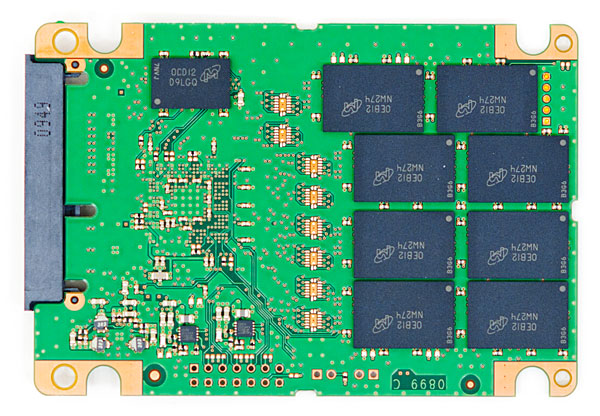
The C300 is pretty affordable by today's standards. The 128GB drive we tested here is selling for $234.99.
Intel SSD 320
Based on Intel's X25-M G2 controller but with new firmware the 320 adds features like real time encryption, however 6Gbps isn't in the cards with this drive:
Intel sent along the 160GB version of the 320, which has a pretty unusual NAND configuration. Remember Intel's controller is a 10-channel architecture and on the front of the PCB we have ten 25nm NAND devices:
These are 16GB NAND devices (two 8GB NAND die per package). That alone is good for the 160GB drive capacity, but the 320 needs more spare area than its predecessor so 160GB won't cut it. Flip the PCB over and you see two 8GB NAND devices:
I'm not entirely sure how Intel is striping data across all of the NAND. It's likely that Intel is simply just interleaving more operations on two of the channels. The 160GB 320 is the most expensive drive here at $304.99, but that's mostly because of the drive's capacity. In terms of cost per GB, the 320 is middle of the road here at $1.906 per GB.
Intel SSD 510
While the 320 is Intel's mainstream drive, the 510 is the high performance 6Gbps offering for enthusiasts. Intel is using Marvell's 6Gbps controller, again with its own custom firmware. The drive uses Intel's 34nm NAND and doesn't support the encryption features of the 320.
Since it uses 34nm NAND, Intel has 16 NAND devices internally each with two 4GB die:
The 510 is our second most expensive drive here at $284.49 and the most expensive on a cost-per-GB basis as well ($2.222):
OCZ's Agility 3 & Vertex 3
OCZ was the first to ship a SF-2281 based drive and now there are multiple offerings in the OCZ lineup. The Vertex 3 uses 25nm IMFT synchronous NAND, while the Agility 3 uses 25nm IMFT asynchronous NAND. As I hinted at in our review of the 240GB Agility 3, I fully expect a lot of pricing fluctuation between these two lines depending on availability of NAND. As a result, today you can buy a Vertex 3 from Newegg for less than you can an Agility 3. Obviously at the same price the Vertex 3 is the recommended drive but I expect to see these two flip flop more in the future.
Internally the Agility 3 (and Vertex 3) use 16 NAND devices with one die per device:
OCZ is very aggressive on Vertex 3 pricing, you can get the 120GB version today for $252.99.
The Test
| CPU |
Intel Core i7 965 running at 3.2GHz (Turbo & EIST Disabled) Intel Core i7 2600K running at 3.4GHz (Turbo & EIST Disabled) - for AT SB 2011, AS SSD & ATTO |
| Motherboard: |
Intel DX58SO (Intel X58) Intel H67 Motherboard |
| Chipset: |
Intel X58 + Marvell SATA 6Gbps PCIe Intel H67 |
| Chipset Drivers: |
Intel 9.1.1.1015 + Intel IMSM 8.9 Intel 9.1.1.1015 + Intel RST 10.2 |
| Memory: | Qimonda DDR3-1333 4 x 1GB (7-7-7-20) |
| Video Card: | eVGA GeForce GTX 285 |
| Video Drivers: | NVIDIA ForceWare 190.38 64-bit |
| Desktop Resolution: | 1920 x 1200 |
| OS: | Windows 7 x64 |


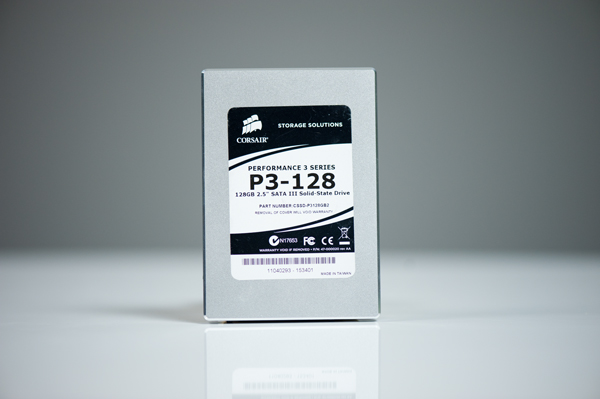

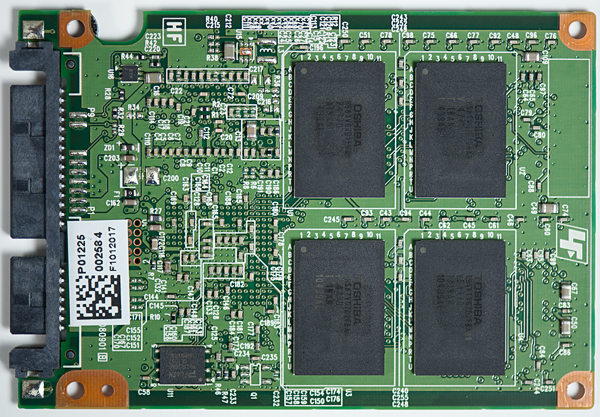
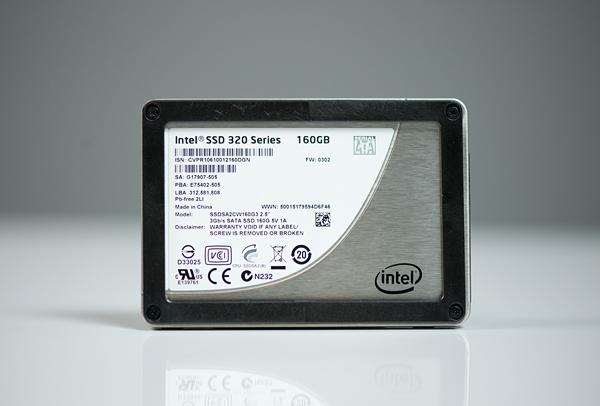
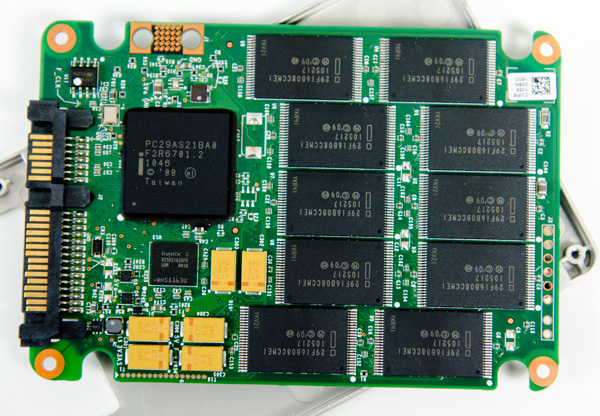
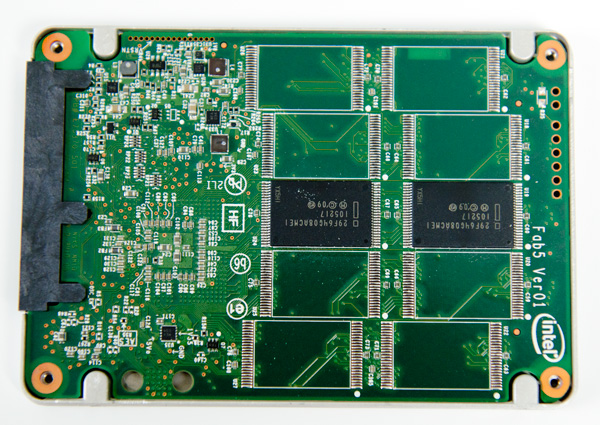
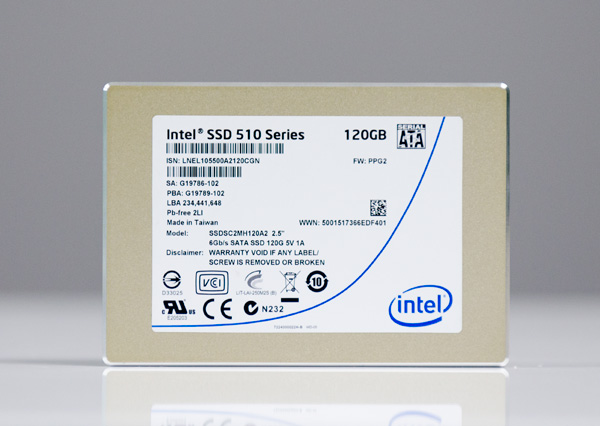
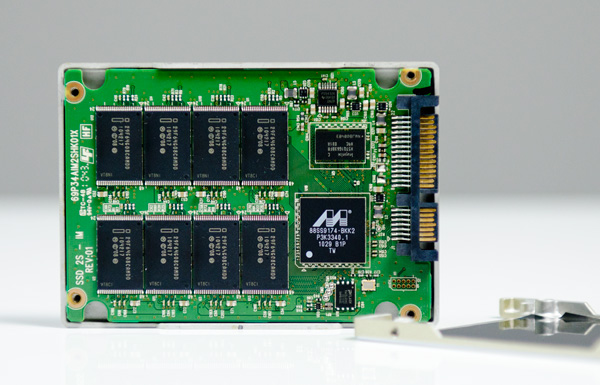
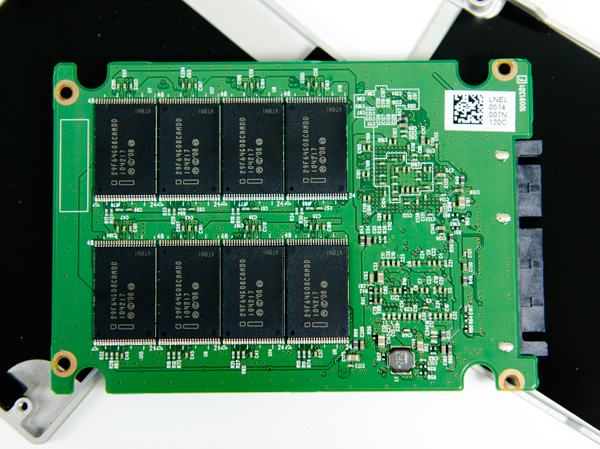
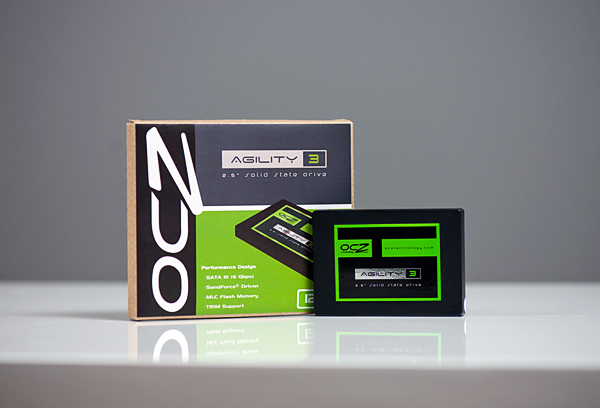
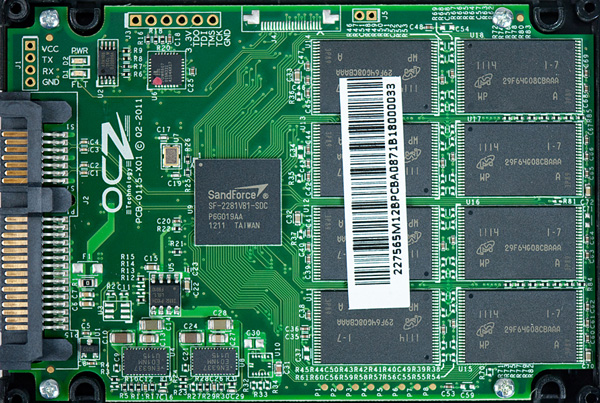
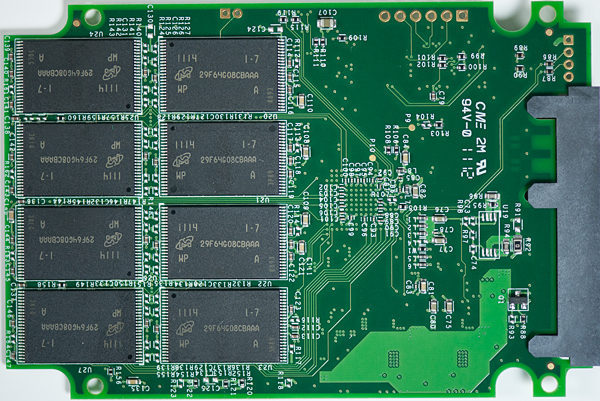








68 Comments
View All Comments
GrizzledYoungMan - Tuesday, June 7, 2011 - link
Just found this: http://www.overclock.net/ssd/956371-whats-best-sat...Basically answers my question right there, haha.
howelk - Wednesday, June 8, 2011 - link
I'm pondering purchase of Crucial m4-256, Intel 510, Samsung 470, or Intel 320 300GB.. system is 790GX/Phenom II 965. I'm interested in mostly hosting a bunch of VM's for home lab.kuzzia - Wednesday, June 8, 2011 - link
Thank you, thank you for also reviewing mainstream SSD's instead of the usual 240 GB. After all, not many people can afford those after all. But wonder why Intel chose to include the 160 GB instead of the 120 GB. Too afraid to show weaknesses of 120 GB?Dribble - Wednesday, June 8, 2011 - link
The 128GB version of that is probably the most popular new drive out there right now being as it's fast but significantly cheaper then the vertex 3 and the Intel 510.KenPC - Wednesday, June 8, 2011 - link
Anand,In previous articles you have very clearly shown that a sandforce sata II drive can write at no more than about 85MB/s. A sandforce sata III drive was about 135 to 150Mb;/s as I recollect.
Any reported value above these numbers is due to compression and caching within the drive controller.
This limitation becomes most clear when truly incompressible files, such as video clips, are used.
First, I question any write speed above these values that claim to be with 'incompressible' data. Even you raised a flag about this in previous articles. Read speeds may also be affected in somewhat the same way.
Sandforce controllers are clever, but you mileage may vary widely. Most benchmark tests are highly affected by the drive controller compression and caching.
Second, if compression and caching are a good thing, why not use the OS to compress and cache? In this case, the SATA bus could no longer be a bottle neck, and speeds that far exceed the SATA II or III specs are available. In this way, everyone can have the effects of a sandforce controller, except perhaps better.
For those interested in trying with a SSD drive, check 'compress this drive to save space' in W7. Then rerun the atto benchmark. I found overwhelming improvement in data transfer rates that far exceeded the sata II/III bus capability.
krazyderek - Wednesday, June 8, 2011 - link
would have loved to see a nice summary of how all the drives perform after being "abused" and trimmed, i remember that some of these drives don't handle it so well..... the c300? really would have liked to see that part of the overall comparison, especially since i'm guessing degraded performance happens to the smaller drives easier.geok1ng - Wednesday, June 8, 2011 - link
I believe that the Intel 320 series still packs a punch, given the cheaper price tag and hardware features absent from the 510 like data encription or absent from all the other consumer SSDs, like an array of caps to prevent data loss from poqer failures. Tha is an aspect of the 320 series that the round up has failed to point out.Between Intel 320 and 510 series the user trades performance for price and reliability. And Intel strategy today is to explaim to people that while there is a huge real world gap between HDD and the slowest SSD of this generation, te real worlds benefits of choosing the fastest SSD today and the slowest are dim to non-existant.
Bigu - Wednesday, June 8, 2011 - link
It's interesting to see that between Intel 510 250GB and 120GB, the smaller drive performs much better in random writes. (from this chart http://www.anandtech.com/show/4244/intel-ssd-320-r...In fact, generally, the gap between these two are smaller than that between 320 300GB and 160GB, as well as OCZ V3 240GB and 120GB.
Fallen Kell - Wednesday, June 8, 2011 - link
This is exactly the kind of comparison I had been looking for, and timing couldn't have been more perfect (I only started looking for this comparison 4 hours AFTER you had posted it). It made my decision pretty easy. I went with the Intel SSD 510 120GB. With the issues that are occurring on all the Sandforce 2200-2500 controllers, I ruled them out (Corsair just recalled all of their drives.... I suspect that others will have to do the same). And the performance really isn't that much worse in general. While I considered the C300, the very small reserved area is what lead me to remove it from my list. So that only left the 2 Intel drives, and given the fact that the 510 performed better and was cheaper (with less disk space), it was the right choice for me.ArtShapiro - Wednesday, June 8, 2011 - link
I too want to extend my appreciation for an informative and understandable article!Am I the only one who has been afraid to jump into the SSD camp due to concerns about reliability? I'm backed up by Windows Home Server daily on all my machines, but the thought of getting bricked is still unpleasant. Yeah, magnetic drives eventually fail, but not very often.
I wonder if this new Z68 caching facility offers the optimal solution - pretty darned fast, a nice improvement over a straight magnetic system, and (I assume) no grievous hardship if the SSD starts pining for the fjords.
Art